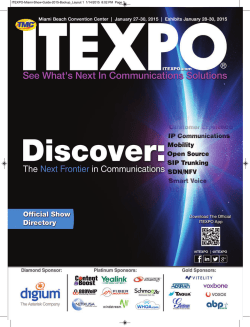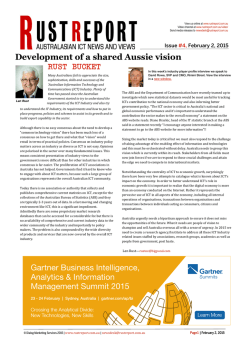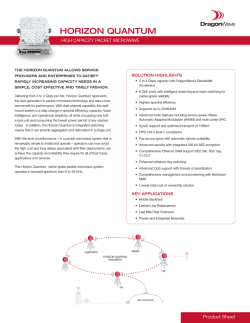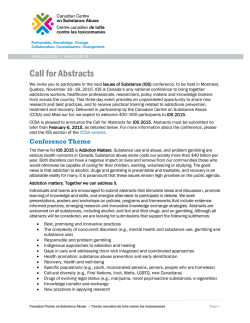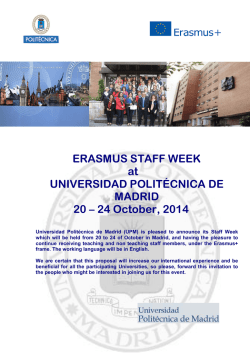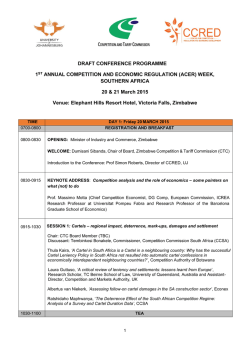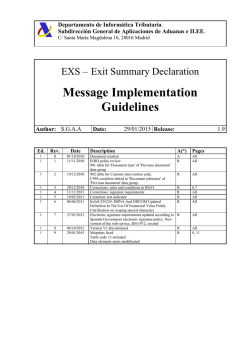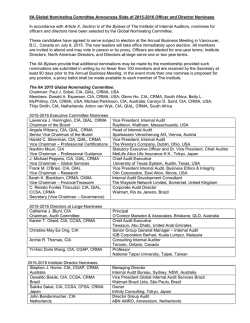
TS 0002 - oneM2M
This Specification is provided for future development work within oneM2M only. The Partners accept no liability for any use of this Specification. The present document has not been subject to any approval process by the oneM2M Partners Type 1. Published oneM2M specifications and reports for implementation should be obtained via the oneM2M Partners' Publications Offices. © oneM2M Partners Type 1 (ARIB, ATIS, CCSA, ETSI, TIA, TTA, TTC) Page 1 of 18 This is a draft oneM2M document and should not be relied upon; the final version, if any, will be made available by oneM2M Partners Type 1. About oneM2M The purpose and goal of oneM2M is to develop technical specifications which address the need for a common M2M Service Layer that can be readily embedded within various hardware and software, and relied upon to connect the myriad of devices in the field with M2M application servers worldwide. More information about oneM2M may be found at: http//www.oneM2M.org Copyright Notification No part of this document may be reproduced, in an electronic retrieval system or otherwise, except as authorized by written permission. The copyright and the foregoing restriction extend to reproduction in all media. © 2015, oneM2M Partners Type 1 (ARIB, ATIS, CCSA, ETSI, TIA, TTA, TTC). All rights reserved. Notice of Disclaimer & Limitation of Liability The information provided in this document is directed solely to professionals who have the appropriate degree of experience to understand and interpret its contents in accordance with generally accepted engineering or other professional standards and applicable regulations. No recommendation as to products or vendors is made or should be implied. NO REPRESENTATION OR WARRANTY IS MADE THAT THE INFORMATION IS TECHNICALLY ACCURATE OR SUFFICIENT OR CONFORMS TO ANY STATUTE, GOVERNMENTAL RULE OR REGULATION, AND FURTHER, NO REPRESENTATION OR WARRANTY IS MADE OF MERCHANTABILITY OR FITNESS FOR ANY PARTICULAR PURPOSE OR AGAINST INFRINGEMENT OF INTELLECTUAL PROPERTY RIGHTS. NO oneM2M PARTNER TYPE 1 SHALL BE LIABLE, BEYOND THE AMOUNT OF ANY SUM RECEIVED IN PAYMENT BY THAT PARTNER FOR THIS DOCUMENT, WITH RESPECT TO ANY CLAIM, AND IN NO EVENT SHALL oneM2M BE LIABLE FOR LOST PROFITS OR OTHER INCIDENTAL OR CONSEQUENTIAL DAMAGES. oneM2M EXPRESSLY ADVISES ANY AND ALL USE OF OR RELIANCE UPON THIS INFORMATION PROVIDED IN THIS DOCUMENT IS AT THE RISK OF THE USER. © oneM2M Partners Type 1 (ARIB, ATIS, CCSA, ETSI, TIA, TTA, TTC) Page 2 of 18 This is a draft oneM2M document and should not be relied upon; the final version, if any, will be made available by oneM2M Partners Type 1. Contents 1 Scope...................................................................................................................................................... 4 2 References .............................................................................................................................................. 4 2.1 2.2 3 3.1 3.2 Normative references ..................................................................................................................................... 4 Informative references ................................................................................................................................... 4 Definitions and abbreviations ................................................................................................................. 4 Definitions ..................................................................................................................................................... 4 Abbreviations ................................................................................................................................................. 4 4 Conventions ........................................................................................................................................... 5 5 Introduction to the M2M ecosystem ....................................................................................................... 5 5.1 6 6.1 6.2 6.3 6.3.1 6.3.2 6.4 6.5 6.6 6.7 7 Functional roles description ........................................................................................................................... 5 Functional Requirements ........................................................................................................................ 6 Overall System Requirements ........................................................................................................................ 6 Management Requirements .......................................................................................................................... 12 Abstraction and Semantics Requirements ..................................................................................................... 12 Abstraction Requirements ....................................................................................................................... 12 Semantics Requirements ......................................................................................................................... 13 Security Requirements ................................................................................................................................. 13 Charging Requirements ................................................................................................................................ 15 Operational Requirements ............................................................................................................................ 16 Communication Request Processing Requirements ...................................................................................... 16 Non-Functional Requirements (non-normative) ................................................................................... 17 History............................................................................................................................................................ 18 © oneM2M Partners Type 1 (ARIB, ATIS, CCSA, ETSI, TIA, TTA, TTC) Page 3 of 18 This is a draft oneM2M document and should not be relied upon; the final version, if any, will be made available by oneM2M Partners Type 1. 1 Scope The present document contains an informative functional role model and normative technical requirements for oneM2M. 2 References 2.1 Normative references References are either specific (identified by date of publication and/or edition number or version number) or non-specific. For specific references, only the cited version applies. For non-specific references, the latest version of the reference document (including any amendments) applies. The following referenced documents are necessary for the application of the present document. [1] 3GPP TS 22.368: "Service requirements for Machine-Type Communications (MTC); Stage 1". [2] oneM2M TR-0008: "Security Analysis". 2.2 Informative references References are either specific (identified by date of publication and/or edition number or version number) or non-specific. For specific references, only the cited version applies. For non-specific references, the latest version of the reference document (including any amendments) applies. The following referenced documents are not necessary for the application of the present document but they assist the user with regard to a particular subject area. [i.1] NOTE: oneM2M Drafting Rules. Available at http://member.onem2m.org/Static_pages/Others/Rules_Pages/oneM2M-Drafting-RulesV1_0.doc. [i.2] oneM2M TS-0011: "Common Terminology". [i.3] 3GPP2 S.R0146: “M2M System Requirements”. NOTE: Available at http://www.3gpp2.org/Public_html/specs/S.R01460_v1.0_M2M_System_Requirements_20120829.pdf. 3 Definitions and abbreviations 3.1 Definitions For the purposes of the present document, the terms and definitions are given in oneM2M TS-0011 [i.2]. 3.2 Abbreviations For the purposes of the present document, the following abbreviations apply: CHA GSMA Continua Health Alliance Global System for Mobile Communications Association © oneM2M Partners Type 1 (ARIB, ATIS, CCSA, ETSI, TIA, TTA, TTC) Page 4 of 18 This is a draft oneM2M document and should not be relied upon; the final version, if any, will be made available by oneM2M Partners Type 1. HSM OMA QoS SMS USSD WAN 4 Hardware Security Module Open Mobile Alliance Quality of Service Short Message Service Unstructured Supplementary Service Data Wide Area Network Conventions The keywords “shall”, “shall not”, “should”, “should not”, “may”, “need not” in the present document are to be interpreted as described in the oneM2M Drafting Rules [i.1]. Note: according to oneM2M Drafting Rules [i.1] in order to mandate a feature in the oneM2M System but allow freedom to the individual deployment whether to use it or not subsequently requirements are often formulated like: “The oneM2M System shall support a mechanism [function, capability...] to …”, or “…shall be able to …”. This does not mandate usage of the required feature in a M2M Solution. 5 Introduction to the M2M ecosystem 5.1 Functional roles description an M2M Solution (end) user M2M Appl. M2M Application operates Common … M2M Service operates …. M2M Applications M2M CS M2M Service Providers M2M Common Services Underlying Network … Connectivity Services Application Service Providers Underlying Network operates Network Operators Figure 1: Functional Roles in the M2M Ecosystem 1) The User (individual or company – aka: end-user) fulfils all of the following criteria: - Uses an M2M solution. © oneM2M Partners Type 1 (ARIB, ATIS, CCSA, ETSI, TIA, TTA, TTC) Page 5 of 18 This is a draft oneM2M document and should not be relied upon; the final version, if any, will be made available by oneM2M Partners Type 1. 2) 3) 4) The Application Service Provider fulfils all of the following criteria: - Provides an M2M Application Service. - Operates M2M Applications. The M2M Service Provider fulfils all of the following criteria: - Provides M2M Services to Application Service Providers. - Operates M2M Common Services. The Network Operator fulfils all of the following criteria: - Provides Connectivity and related services for M2M Service Providers. - Operates an Underlying Network. Such an Underlying Network could e.g. be a telecom network. Any of the above functional roles may coincide with any of the other roles. These functional roles do not imply business roles or architectural assumptions. 6 Functional Requirements 6.1 Overall System Requirements Table 1: Overall System Requirements Requirement ID OSR-001 Description The oneM2M System shall allow communication between M2M Applications by using multiple communication means based on IP Access. OSR-002a The oneM2M System shall support communication means that can accommodate devices with constrained computing (e.g. small CPU, memory, battery) or communication capabilities (e.g. 2G wireless modem, certain WLAN node). The oneM2M System shall support communication means that can accommodate devices with rich computing capabilities (e.g. large CPU, memory) or communication (e.g. 3/4G wireless modem, wireline). OSR-002b OSR-003 The oneM2M System shall support the ability to maintain peer-to-peer M2M Session in coordination with application session for those M2M Applications that require it. OSR-004 The oneM2M System shall support session-less application communications for those M2M Applications that require it. OSR-005 The oneM2M System shall be able to expose the services offered by telecommunications networks to M2M Applications (e.g. SMS, USSD, localization, subscription configuration, authentication (e.g. Generic Bootstrapping Architecture), etc.),subject to restriction based on Network Operator’s policy. OSR-006 The oneM2M System shall be able to reuse the services offered by Underlying Networks to M2M Applications and/or M2M Services by means of open access models (e.g. OMA, GSMA OneAPI framework).Examples of available services are: IP Multimedia communications. Messaging. Location. Charging and billing services. Device information and profiles. Configuration and management of devices. Release Implemented in Rel-1 Implemented in Rel-1 Implemented in Rel-1 Partially implemented in Rel-1 (see note 21) © oneM2M Partners Type 1 (ARIB, ATIS, CCSA, ETSI, TIA, TTA, TTC) Implemented in Rel-1 Partially implemented in Rel-1 (see note 9) Partially implemented in Rel-1 (see note 10) Page 6 of 18 This is a draft oneM2M document and should not be relied upon; the final version, if any, will be made available by oneM2M Partners Type 1. Requirement ID Description Triggering, monitoring of devices. Small data transmission. Group management. (see note 1). The oneM2M System shall provide a mechanism for M2M Applications to interact with the Applications and data/information managed by a different M2M Service Provider, subject to permissions as appropriate. Implemented in Rel-1 OSR-008 The oneM2M System shall provide the capability for M2M Applications to communicate with an M2M Device (i.e. application in the device) without the need for the M2M Applications to be aware of the network technology and the specific communication protocol of the M2M Device. Implemented in Rel-1 (see note 11) OSR-009 The oneM2M System shall support the ability for single or multiple M2M Applications to interact with a single or multiple M2M Devices/Gateways (application in the device/gateway) (see note 2). Implemented in Rel-1 OSR-010 The oneM2M System shall support mechanisms for confirmed delivery of a message to its addressee to those M2M Applications requesting reliable delivery to dectect failure of message within a given time interval. Implemented in Rel-1 OSR-011a The oneM2M System shall be able to request different communication paths, from the Underlying Network based on Underlying Network Operator and/or M2M Service Provider policies, routing mechanisms for transmission failures. OSR-011b The oneM2M System shall be able to request different communication paths from the Underlying Network based on request from M2M Applications. OSR-012 The oneM2M System shall support communications between M2M Applications and Devices supporting M2M Services by means of continuous or noncontinuous connectivity. Implemented in Rel-1 OSR-013 The oneM2M System shall be aware of the delay tolerance acceptable by the M2M Application and shall schedule the communication accordingly or request the Underlying Network to do it, based on policies criteria. Implemented in Rel-1 OSR-014 The oneM2M System shall be able to communicate with M2M Devices, behind an M2M Gateway that supports heterogeneous M2M Area Networks. OSR-015 The oneM2M System shall be able to assist Underlying Networks that support different communication patterns including infrequent communications, small data transfer, transfer of large file and streamed communication. OSR-016 The oneM2M System shall provide the capability to notify M2M Applications of the availability of, and changes to, available M2M Application/management information on the M2M Device/Gateway, including changes to the M2M Area Network. OSR-017 The oneM2M System shall be able to offer access to different sets of M2M Services to M2M Application Providers. The minimum set of services are: Connectivity management. Device management (service level management). Application Data management. In order to enable different deployment scenarios, these services shall be made available by the oneM2M System, individually, as a subset or as a complete set of services. The oneM2M System shall be able to offer M2M Services to M2M Devices roaming across cellular Underlying Networks,subject to restriction based on Network Operator’s policy (see note 3). OSR-007 OSR-018 OSR-019 The oneM2M System shall support the capabilities for data repository (i.e. to collect/store) and for data transfer from one or more M2M Devices or M2M Gateways, for delivery to one or more M2M Gateways, M2M Services © oneM2M Partners Type 1 (ARIB, ATIS, CCSA, ETSI, TIA, TTA, TTC) Release Implemented in Rel-1 (see note 12) Not implemented in Rel-1 Implemented in Rel-1 Partially implemented in Rel-1 (see note 13) Implemented in Rel-1 Implemented in Rel-1 Implemented in Rel-1 with some limitations (see note 14) Implemented Page 7 of 18 This is a draft oneM2M document and should not be relied upon; the final version, if any, will be made available by oneM2M Partners Type 1. Requirement ID OSR-020 Description Infrastructure, or M2M Application Infrastructure, in ways requested by the M2M Application Infrastructure as listed below: action initiated either by an M2M Device, M2M Gateway, M2M Services Infrastructure, or M2M Application Infrastructure; when triggered by schedule or event; for specified data. The oneM2M System shall be able to support policies and their management regarding the aspects of storage and retrieval of data/information. OSR-021 The oneM2M System shall be able to provide mechanisms to enable sharing of data among multiple M2M Applications. OSR-022 When some of the components of a oneM2M System Solution are not available (e.g. WAN connection lost), the oneM2M System shall be able to support the normal operation of components of the oneM2M System Solution that are available. The oneM2M System shall be able to identify the M2M Services to be used by M2M Service Subscriptions (see note 4). OSR-023 Release in Rel-1 Implemented in Rel-1 Implemented in Rel-1 Implemented in Rel-1 Implemented in Rel-1 OSR-024 The oneM2M System shall be able to identify the M2M Devices used by M2M Service Subscriptions. OSR-025 The oneM2M System shall be able to identify the M2M Applications used by M2M Service Subscriptions. OSR-026 If provided by the Underlying Network, the oneM2M System shall be able to associate the M2M Device used by M2M Service Subscriptions with the device identifiers offered by the Underlying Network and the device. Implemented in Rel-1 OSR-027 The oneM2M System shall provide a generic mechanism to support transparent exchange of information between the M2M Application and the Underlying Network, subject to restriction based on M2M Service Provider’s policy and/or Network Operator’s policy (see note 5). Not implemented in Rel-1 OSR-028 The oneM2M System shall enable an M2M Application to define trigger conditions in the oneM2M System such that the oneM2M System autonomously sends a series of commands to actuators on behalf of the M2M Application when these contitions are met. Not implemented in Rel-1 OSR-029 The oneM2M System shall be able to support sending common command(s) to each actuator or sensor via a group. OSR-030 The oneM2M System shall be able to support the management (i.e. addition, removal, retrieval and update) of the membership of a group. OSR-031 The oneM2M System shall be able to support a group as a member of another group. OSR-032 The oneM2M System shall be able to support Event Categories (e.g. normal, urgency) associated with data for M2M Applications when collecting, storing and reporting that data (see note 6). OSR-033 Based on the Dynamic Device/Gateway Context of the M2M Gateway and/or Device and the defined Event Categories, the oneM2M System shall provide the capability to dynamically adjust the scheduling of reporting and notification of the M2M Device/Gateway (see note 17).. OSR-034 The oneM2M System shall support seamless replacement of M2M Devices as well as M2M Gateways (e.g. redirecting traffic, connection, recovery, etc.). OSR-035 The oneM2M System shall support the exchange of non-M2M Application related relevant information (e.g. Device/Gateway classes) between M2M © oneM2M Partners Type 1 (ARIB, ATIS, CCSA, ETSI, TIA, TTA, TTC) Implemented in Rel-1 Implemented in Rel-1 Implemented in Rel-1 Implemented in Rel-1 Implemented in Rel-1 Implemented in Rel-1 Partially implemented in Rel-1 (see note 15) Not implemented in Rel-1 Not implemented Page 8 of 18 This is a draft oneM2M document and should not be relied upon; the final version, if any, will be made available by oneM2M Partners Type 1. Requirement ID OSR-036 Description Device/Gateway and M2M Service Infrastructure for the purpose of efficient communication facilitation. This includes the capability for an M2M Device to report its device class to M2M Service Infrastructure and for the M2M Service Infrastructure to inform M2M Device of the M2M Service Infrastruture capabilities. The oneM2M System should provide mechanisms to accept requests from M2M Application Service Providers for compute/analytics services. Release in Rel-1 Not implemented in Rel-1 OSR-037 The oneM2M System shall enable an M2M Application to request to send data, in a manner independent of the Underlying Network, to the M2M Applications of a group of M2M Devices and M2M Gateways in geographic areas that are specified by the M2M Application. OSR-038 The oneM2M System shall support the inclusion of M2M Application’s QoS preference in service requests to Underlying Networks. OSR-039 The oneM2M System shall be able to authorize service requests with QoS preference at service level, but shall pass M2M Application’s QoS preference in service requests to Underlying Network for authorization and granting or negotiation of the service QoS requests. OSR-040 The oneM2M System shall be able to leverage multiple communication mechanisms (such as USSD or SMS) when available in the Underlying Networks. OSR-041 The oneM2M System shall provide a mechanism, which supports the addition of new M2M Services to the oneM2M System as independent portable modules by means of the oneM2M interfaces. OSR-042 The oneM2M System shall be able to support different QoS-levels specifying parameters, such as guaranteed bitrate, delay, delay variation, loss ratio and error rate, etc. OSR-043 The oneM2M System shall be able to verify that members of a group support a common set of functions. OSR-044 The oneM2M System shall support communication with M2M Devices which are reachable based on defined time schedules (e.g. periodic) as well as M2M Devices which are reachable in an unpredictable and spontaneous manner. OSR-045a The oneM2M System shall be able to receive and utilize information provided by the Underlying Network about when an M2M Device can be reached. OSR-045b The oneM2M System shall be able to utilize reachability schedules generated by either the M2M Device or the Infrastructure Domain. OSR-046 The oneM2M System shall be able to support a capability for the M2M Application to request / disallow acknowledgement for its communication. OSR-047 The oneM2M System shall be able to support mechanism for the M2M Devices and/or Gateways to report their geographical location information to M2M Applications (see note 7). Implemented in Rel-1 OSR-048 The oneM2M System shall provide an M2M Service that allows M2M Devices and/or Gateways to share their own or other M2M Devices’ geographical Implemented Not implemented in Rel-1 Not implemented in Rel-1 Not implemented in Rel-1 Not implemented in Rel-1 (see note 16) Partially implemented (see note 22) © oneM2M Partners Type 1 (ARIB, ATIS, CCSA, ETSI, TIA, TTA, TTC) Not implemented in Rel-1 Implemented in Rel-1 Implemented in Rel-1 Not implemented in Rel-1 Partially implemented in Rel-1 (see note 18) Not implemented in Rel-1 Page 9 of 18 This is a draft oneM2M document and should not be relied upon; the final version, if any, will be made available by oneM2M Partners Type 1. Requirement ID Description Release location information (see note 7). OSR-049 The oneM2M System shall be able to provide the capability for an M2M Application to selectively share data (e.g. access control) among applications. OSR-050 If communication over one communication channel provided by the Underlying Network can only be triggered by one side (Infrastructure Domain or Field Domain), and alternative channel(s) is (are) available in the other direction, the oneM2M System shall be able to use the alternative channel(s) to trigger bidirectional communication on the first channel. Depending on availability of suitable interfaces provided by the Underlying Network the oneM2M System shall be able to request the Underlying Network to broadcast / multicast data to a group of M2M Devices in a specified area. OSR-051 in Rel-1 Implemented in Rel-1 Implemented in Rel-1 Implemented in Rel-1 OSR-052 The oneM2M System shall be able to select an appropriate Underlying Network to broadcast or multicast data depending on the network’s broadcast/multicast support and the connectivity supported by the targeted group of M2M Devices/Gateways. OSR-053 The oneM2M System shall provide a means that enables backward compatibility of interfaces among different releases (see note 8). OSR-054 The oneM2M System shall be able to support an M2M Application, M2M Device, or M2M Gateway to obtain access to resources of another M2M Application, M2M Device, or M2M Gateway. Implemented in Rel-1 OSR-055 The oneM2M System shall be able to provide the capability of M2M Applications to exchange data with one or more authorized M2M Applications which are not known in advance. Implemented in Rel-1 OSR-056 The oneM2M System shall enable discovery of usable M2M Applications on an M2M Gateway or at an M2M Device . OSR-057 The oneM2M System shall enable discovery of M2M Gateways and M2M Devices available to an M2M Application for data exchange. OSR-058 The oneM2M System shall be able to provide time stamps as needed by common service functions. OSR-059 The oneM2M System shall be able to support Role-based access control based on M2M Service Subscriptions. OSR-060 The oneM2M System should support time synchronization with an external clock source. OSR-061 M2M Devices and M2M Gateways may support time synchronization within the oneM2M System. OSR-062 The oneM2M System shall enable means of testing the connectivity towards a set of M2M Applications. OSR-063 The oneM2M System shall be able to manage the scheduling of M2M Service Layer connectivity and messaging between the Infrastracture Domain and M2M Devices/Gateways. OSR-064 The oneM2M System shall be able to aggregate messages depending on message delay tolerance and/or category. OSR-065 The oneM2M System shall provide mechanisms that enable a M2M Service Provider to distribute processing functions to his M2M Devices/Gateways in the Not implemented in Rel-1 Not implemented in Rel-1 (see note 20) © oneM2M Partners Type 1 (ARIB, ATIS, CCSA, ETSI, TIA, TTA, TTC) Implemented in Rel-1 Implemented in Rel-1 Implemented in Rel-1 Implemented in Rel-1 Not implemented in Rel-1 Not implemented in Rel-1 Not implemented in Rel-1 Implemented in Rel-1 Implemented in Rel-1 Not implemented Page 10 of 18 This is a draft oneM2M document and should not be relied upon; the final version, if any, will be made available by oneM2M Partners Type 1. Requirement ID Description Release Field Domain in Rel-1 OSR-066 The oneM2M System shall be able to support the placement and operation of M2M Applications in selected M2M nodes per criteria requested by M2M Application Service Providers, subject to access rights. OSR-067 The oneM2M System shall be able to take operational and management action as requested by M2M Applications. OSR-068 When available from an Underlying Network, the oneM2M System shall be able to provide the capability to retrieve and report the information regarding whether an M2M Device is authorized to access Underlying Network services. OSR-069 When available from the Underlying Network, the oneM2M System shall be able to maintain the M2M Service Operational Status of a M2M Device and update it when the Underlying Network connectivity service status changes. OSR-070 The oneM2M System shall be able to provide the capability to notify an authorized M2M Application when the M2M Service Administrative State or M2M Service Operational Status of an M2M Device changes, if that M2M Application has subscribed for such notifications. OSR-071 The oneM2M System shall be able to enable an authorized M2M Application to set the M2M Service Administrative State of a M2M Device. OSR-072 The oneM2M System shall be able to initiate a set of well-defined actions (e.g. trigger upon a threshold, compare a value, etc.) to one or more M2M Application(s) on behalf of another M2M Application. Implemented in Rel-1 Implemented in Rel-1 Not implemented in Rel-1 Not implemented in Rel-1 Partially implemented in Rel-1 (see note 19) Implemented in Rel-1 Implemented in Rel-1 NOTE 1: The set of features or APIs to be supported depends on the M2M Common Services and access to available APIs. NOTE 2: The relation M2M Network Application to M2M Device/Gateway may be 1:1, 1:n, n:1 and/or n:m. NOTE 3: No roaming on M2M Service level is assumed by this requirement. NOTE 4: M2M Service Subscriptions are not Application subscriptions (e.g. Home Energy Management). NOTE 5: Transparent exchange of information implies information that is mainly interpreted by the M2M Application and the Underlying Network Provider. NOTE 6: Based on the Event Categories and via interworking with Underlying Networks, the oneM2M System can support differentiated services (by providing Quality-of-Service) requested by M2M Applications. NOTE 7: Geographical location information can be more than simply longitude and latitude. NOTE 8: “means” above does not imply only technical mechanisms. NOTE 9: In Rel-1 only GBA and localization are available NOTE 10: Rel-1 covers: Location, Charging and billing services, Configuration and management of devices, Device information and profiles, Triggering NOTE 11: This requirement applies to M2M Devices but not to devices interworked via M2M Area Networks NOTE 12: Based on device triggering. NOTE 13: No Support for streamed communication NOTE 14: Limitations to trigger (via Tsp interface) devices in a roamed-to network. NOTE 15: Detail syntax to describe Dynamic Context is not specified NOTE 16: it is possible to deliver CoAP over SMS, but currently SMS message delivery interfaces are not expicitely defined. NOTE 17: For example, if the battery of Gateway is remained only 10% or below, the Gateway notifies the M2M service platform of the status. The M2M Application in the Infrastructure node will adjust the scheduling of reporting and notification based on the Event Categories associated with each message. Consequently, the M2M Gateway operates longer. NOTE 18: Only reachability schedules generated by the Infrastructure Domain can be utilized. NOTE 19: Only the M2M Service Administrative State can be notified. M2M Service Operational Status is not implemented. NOTE 20: this can be implemented based on preconfigured access rights. NOTE 21: No support for peer-to-peer service layer session. NOTE 22: In Rel-1 this is supported by means of the Mca interfaces, mapping the new service module to an AE. © oneM2M Partners Type 1 (ARIB, ATIS, CCSA, ETSI, TIA, TTA, TTC) Page 11 of 18 This is a draft oneM2M document and should not be relied upon; the final version, if any, will be made available by oneM2M Partners Type 1. 6.2 Management Requirements Table 2: Management Requirements Requirement ID MGR-001 MGR-002 MGR-003 MGR-004 MGR-005 MGR-006 MGR-007 MGR-008 MGR-009 MGR-010 MGR-011 MGR-012 Description The oneM2M System shall be able to support management and configuration of M2M Gateways/ Devices including resource constrained M2M Devices. The oneM2M System shall provide the capability to discover the M2M Area Networks including information about devices on those networks and the parameters (e.g. topology, protocol) of those networks. The oneM2M System shall be able to provide the capability to maintain and describe the management information model of devices and parameters (e.g. topology, protocol) of M2M Area Networks. The oneM2M System shall support common means to manage devices enabled by different management technologies (e.g. OMA DM, BBF TR069). The oneM2M System shall provide the capability to manage multiple devices in a grouped manner. The oneM2M System shall provide the capability for provisioning and configuration of devices in M2M Area Networks . The oneM2M System shall provide the capability for monitoring and diagnostics of M2M Gateways/Devices in M2M Area Networks . The oneM2M System shall provide the capability for software management of devices in M2M Area Networks. The oneM2M System shall provide the capability for rebooting and/or resetting of M2M Gateways/Devices and other devices in M2M Area Networks. The oneM2M System shall provide the capability for authorizing devices to access M2M Area Networks. The oneM2M System shall provide the capability for modifying the topology of devices in M2M Area Networks,subject to restriction based on M2M Area Network policies.. Upon detection of a new device the M2M Gateway shall be able to be provisioned by the M2M Service Infrastructure with an appropriate configuration which is required to handle the detected device. Release Implemented in Rel-1 Implemented in Rel-1 Implemented in Rel-1 Implemented in Rel-1 Implemented in Rel-1 Implemented in Rel-1 Implemented in Rel-1 Implemented in Rel-1 Implemented in Rel-1 Implemented in Rel-1 Implemented in Rel-1 Partially implemented in Rel-1 (see note 1) MGR-013 MGR-014 Void The oneM2M System shall be able to retrieve events and information logged by Implemented M2M Gateways/ Devices and other devices in M2M Area Networks. in Rel-1 MGR-015 The oneM2M System shall be able to support firmware management Implemented (e.g. update) of M2M Gateways/ Devices and other devices in M2M Area in Rel-1 Networks. MGR-016 The oneM2M System shall be able to retrieve information related to the Static Implemented and Dynamic Device/Gateway Context for M2M Gateways/Devices as well as in Rel-1 Device Context for other devices in M2M Area Networks. MGR-017 The oneM2M System shall be capable of correlating Access Management Implemented elements provided by the technology specific Device Management Protocols to in Rel-1 Access Management elements used by the oneM2M System Note 1: In Rel-1 no detection mechanism exists, but once an M2M Device is known at the Gateway it can be configured via the GW through DM. 6.3 Abstraction and Semantics Requirements 6.3.1 Abstraction Requirements Table 3: Abstraction Requirements Requirement ID ABR-001 ABR-002 ABR-003 Description The oneM2M System shall define a structure of an Information Model for the purpose of exchanging data. Release Not implemented in Rel-1 The oneM2M System shall be able to provide translation mechanisms between Not Information Models used by M2M Applications, M2M Devices/Gateways, and implemented other devices. in Rel-1 The oneM2M System shall provide capabilities to represent Virtual Devices and Not © oneM2M Partners Type 1 (ARIB, ATIS, CCSA, ETSI, TIA, TTA, TTC) Page 12 of 18 This is a draft oneM2M document and should not be relied upon; the final version, if any, will be made available by oneM2M Partners Type 1. Things. 6.3.2 implemented in Rel-1 Semantics Requirements Table 4: Semantics Requirements Requirement ID SMR-001 SMR-002 SMR-003 SMR-004 The oneM2M System shall provide capabilities to discover M2M Resources based on semantic descriptions. SMR-005 The oneM2M System shall support the capability to access semantic descriptions which are outside of the oneM2M System. SMR-006 The oneM2M System shall be able to support capabilities for performing M2M data Analytics based on semantic descriptions from M2M Applications and /or from the oneM2M System. The oneM2M System shall be able to provide capabilities for performing Semantic Mash-up using M2M data from M2M Applications and/or from the oneM2M System (e.g. to create Virtual Devices, offer new M2M Services, etc.) SMR-007 6.4 Description The oneM2M System shall provide capabilities to manage semantic descriptions of resources and M2M Applications, e.g. create, retrieve, update, delete, associate/link. The oneM2M System shall support a common modeling language for semantic descriptions (including relationships between Things) in order to make them available to M2M Applications. The oneM2M System shall be able to provide interworking capabilities between different modeling languages for semantic descriptions. Release Not implemented in Rel-1 Not implemented in Rel-1 Not implemented in Rel-1 Not implemented in Rel-1 Not implemented in Rel-1 Not implemented in Rel-1 Not implemented in Rel-1 Security Requirements Table 5: Security Requirements Requirement ID SER-001 Description The oneM2M System shall incorporate protection against threats to its availability such as Denial of Service attacks. SER-002 The oneM2M System shall be able to ensure the confidentiality of data. SER-003 The oneM2M System shall be able to ensure the integrity of data. SER-004 SER-005 SER-006 SER-007 SER-008 Release Partly Implemented in Rel-1 Implemented in Rel-1 In case where the M2M Devices support USIM/UICC and the Underlying Networks support network layer security, the oneM2M System shall be able to leverage device’s USIM / UICC credentials and network’s security capability e.g. 3GPP GBA for establishing the M2M Services and Applications level security through interfaces to Underlying Network. In case where the M2M Devices support USIM/UICC and the Underlying Networks support network layer security, and when the oneM2M System is aware of Underlying Network’s bootstrapping capability e.g. 3GPP GBA, the oneM2M System shall be able to expose this capability to M2M Services and Applications through API. In case where the M2M Devices support USIM / UICC and the Underlying Networks support network layer security, the oneM2M System shall be able to leverage device’s USIM / UICC credentials when available to bootstrap M2M security association. When some of the components of an M2M Solution are not available (e.g. WAN connection lost), the oneM2M System shall be able to support the confidentiality and the integrity of data between authorized components of the M2M Solution that are available. The oneM2M System shall support countermeasures against unauthorized © oneM2M Partners Type 1 (ARIB, ATIS, CCSA, ETSI, TIA, TTA, TTC) Implemented in Rel-1 Implemented in Rel-1 Implemented in Rel-1 Implemented in Rel-1 Implemented in Rel-1 Implemented Page 13 of 18 This is a draft oneM2M document and should not be relied upon; the final version, if any, will be made available by oneM2M Partners Type 1. Requirement ID SER-009 SER-010 SER-011 SER-012 SER-013 SER-014 SER-015 Description access to M2M Services and M2M Application Services. Release in Rel-1 The oneM2M System shall be able to support mutual authentication for interaction with Underlying Networks, M2M Services and M2M Application Services. The oneM2M System shall be able to support mechanisms for protection against misuse, cloning, substitution or theft of security credentials. The oneM2M System shall protect the use of the identity of an M2M Stakeholder within the oneM2M System against discovery and misuse by other stakeholders. The oneM2M System shall be able to support countermeasures against Impersonation attacks and Replay attacks. The oneM2M System shall be able to provide the mechanism for integritychecking on boot, periodically on run-time, and on software upgrades for software/hardware/firmware component(s) on M2M Device(s). The oneM2M System shall be able to provide configuration data to an authenticated and authorized M2M Application in the M2M Gateway/Device. The oneM2M System shall be able to support mechanisms to provide Subscriber identity to authorized and authenticated M2M Applications when the oneM2M System has the Subscriber’s consent. Implemented in Rel-1 Implemented in Rel-1 Implemented in Rel-1 Partly implemented in Rel-1 (see note 3) Not implemented in Rel-1 Implemented in Rel-1 Partly implemented in Rel-1 (see note 4) SER-016 SER-017 SER-018 SER-019 SER-020 SER-021 SER-022 SER-023 The oneM2M System shall be able to support non repudiation within the M2M service layer and in its authorized interactions with the network and application layers. The oneM2M System shall be able to mitigate threats identified in oneM2M TR-0008 [2]. The oneM2M System shall enable an M2M Stakeholder to use a resource or service and be accountable for that use without exposing its identity to other stakeholders. The oneM2M System shall be able to use service-level credentials present inside the M2M device for establishing the M2M Services and Applications level security. The oneM2M System shall enable legitimate M2M Service Providers to provision their own credentials into the M2M Devices/Gateways. The oneM2M System shall be able to remotely and securely provision M2M security credentials in M2M Devices and/or M2M Gateways. The oneM2M System shall enable M2M Application Service Providers to authorize interactions involving their M2M Applications on supporting entities (e.g. Devices/ Gateways/ Service infrastructure). Where a Hardware Security Module (HSM) is supported, the oneM2M System shall be able torely onthe HSM to provide local security. SER-024 The oneM2M System shall enable M2M Applications to use different and segregated security environments. SER-025 The oneM2M System shall be able to prevent unauthorized M2M Stakeholders from identifying and/or observing the actions of other M2M Stakeholders in the oneM2M System, e.g. access to resources and services (see note 1). Implemented in Rel-1 Implemented in Rel-1 Partly implemented in Rel-1 Implemented in Rel-1 Implemented in Rel-1 Implemented in Rel-1 Implemented in Rel-1 Partly implemented in Rel-1 Partly implemented in Rel-1 Partly implemented in Rel-1 SER-026 The oneM2M System shall be able to provide mechanism for the protection of Implemented confidentiality of the geographical location information (see note 2). in Rel-1 NOTE 1: The above requirement does not cover items outside of the oneM2M System, e.g. Underlying Networks. NOTE 2: Geographical location information can be more than simply longitude and latitude. NOTE 3: Partly supported for Impersonation attacks not supported for Replay attacks. NOTE 4: The oneM2M System has no means to verify a subscriber’s consent. This requirement is only fulfillable at application level. © oneM2M Partners Type 1 (ARIB, ATIS, CCSA, ETSI, TIA, TTA, TTC) Page 14 of 18 This is a draft oneM2M document and should not be relied upon; the final version, if any, will be made available by oneM2M Partners Type 1. 6.5 Charging Requirements Table 6: Charging Requirements Requirement ID CHG-001 CHG-002 Description The oneM2M System shall support collection of charging specific information related to the individual services facilitated by the oneM2M System (e.g. Data Management, Device Management and/or Connectivity Management). Collection of charging specific information shall be possible concurrent with the resource usage.The format of the recorded information shall be fully specified including mandatory and optional elements. The oneM2M System shall support mechanisms to facilitate correlation of charging information (e.g. of a User) collected for M2M Services, M2M Application Services and services provided by underlying network operators. CHG-003 The oneM2M System shall provide means to coordinate charging data records for data usages with differentiated QoS from the Underlying Network. CHG-004 The oneM2M System shall be able to utilize existing charging mechanisms of Underlying Networks. Release Implemented in Rel-1 (see note 4) Partially implemented in Rel-1 (see note 2) Not implemented in Rel-1 Not implemented in Rel-1 (see note 3) CHG-005 The oneM2M System shall support transfer of the charging information records Implemented to the Billing Domain of the M2M Service Provider, for the purpose of: in Rel-1 subscriber billing; inter-provider billing; provider-to-subscriber accounting including additional functions like statistics. CHG-006 The oneM2M System should support generation of charging events for the Not purpose of requesting resource usage authorization from the real time credit implemented control system where the subscriber account is located. The information in Rel-1 contained in the charging events and the relevant chargeable events shall be fully specified including mandatory and optional elements (see note 1). NOTE1: A chargeable event is any activity, a provider may want to charge for that utilizes the resources and related M2M Services offered by such provider. A charging event is the set of charging information needed by the credit control system for resource authorization. NOTE 2: Information collected can be sent to the Underlying Networks which may used it for charging. NOTE 3: the oneM2M service layer can pass info to Underlying Networks but cannot use underlying network mechanism. Charging can be done by underlying network. This is covered by CHG-002. NOTE 4: only supported in the Infrastructure Node. © oneM2M Partners Type 1 (ARIB, ATIS, CCSA, ETSI, TIA, TTA, TTC) Page 15 of 18 This is a draft oneM2M document and should not be relied upon; the final version, if any, will be made available by oneM2M Partners Type 1. 6.6 Operational Requirements Table 7: Charging Requirements Requirement ID OPR-001 Description Release The oneM2M System shall provide the capability for monitoring and diagnostics Implemented of M2M Applications. in Rel-1 OPR-002 The oneM2M System shall provide the capability for software management of M2M Applications. OPR-003 The oneM2M System shall be able to configure the execution state an M2M Application (start, stop, restart). OPR-004 When suitable interfaces are provided by the Underlying Network, the oneM2M System shall have the ability to schedule traffic via the Underlying Network based on instructions received from the Underlying Network. OPR-005 The oneM2M System shall be able to exchange information with M2M Not Applications related to usage and traffic characteristics of M2M Devices or M2M implemented Gateways by the M2M Application. This should include support for the 3GPP in Rel-1 feature called: “Time controlled” (see note 1). OPR-006 Depending on availability of suitable interfaces provided by the Underlying Network the oneM2M System shall be able to provide information related to usage and traffic characteristics of M2M Devices or M2M Gateways to the Underlying Network. NOTE1: 6.7 Implemented in Rel-1 Implemented in Rel-1 Not implemented in Rel-1 Not implemented in Rel-1 “Time controlled” is equivalent to the MTC Features specified in clause 7.2 of 3GPP TS 22.368 [1]. Communication Request Processing Requirements Table 8: Communication Request Processing Requirements Requirement ID CRPR-001 CRPR-002 CRPR-003 CRPR-004 CRPR-005 Description The oneM2M System shall provide to M2M Applications a communication service which provides buffering of messages to/from M2M Gateway / Device / Infrastructure Domain. The oneM2M System shall be able to support forwarding buffered messages depending on communication policies and based on service preference associated with the buffered messages. The oneM2M System shall enable an M2M Application to send a communication request with the following service preference: QoS parameters, including delay tolerance, for initiating the delivery of data; categorizing communication requests into different levels of priority or QoS classes. The oneM2M System shall be able to support concurrent processing of messages within M2M Gateways and/or M2M Devices from different sources with awareness for the service preference associated with the messages while observing the provisioned communication policies. The oneM2M System shall be able to maintain context associated with M2M sessions (e.g. security context or network connectivity context during the interruption of the session). Release Implemented in Rel-1 Implemented in Rel-1 Implemented in Rel-1 Implemented in Rel-1 Partially implemented in Rel-1 (see note 1) NOTE 1: Long lived security context and registration is covered, M2M Sessions are not covered. © oneM2M Partners Type 1 (ARIB, ATIS, CCSA, ETSI, TIA, TTA, TTC) Page 16 of 18 This is a draft oneM2M document and should not be relied upon; the final version, if any, will be made available by oneM2M Partners Type 1. 7 Non-Functional Requirements (non-normative) This clause is intended to gather high-level principles and guidelines that shall govern the design of the oneM2M System. Such principles and guidelines are fundamental to the design of the oneM2M System. But as they cannot necessarily be expressed as requirements per se, they shall be introduced and expressed in this clause. Table 9: Non-Functional Requirements Requirement ID NFR-001 NFR-002 Description Continua Health Alliance is incorporating a RESTful approach to its design. To support CHA, oneM2M should consider RESTful styles and approaches while designing the M2M architecture. The oneM2M System should communicate using protocols that are efficient in terms of amount of exchanged information over amount of exchanged data measured in bytes. © oneM2M Partners Type 1 (ARIB, ATIS, CCSA, ETSI, TIA, TTA, TTC) Release Implemented in Rel-1 Implemented in Rel-1 Page 17 of 18 This is a draft oneM2M document and should not be relied upon; the final version, if any, will be made available by oneM2M Partners Type 1. History Publication history V1.0.1 30 Jan 2015 Release 1 - Publication © oneM2M Partners Type 1 (ARIB, ATIS, CCSA, ETSI, TIA, TTA, TTC) Page 18 of 18 This is a draft oneM2M document and should not be relied upon; the final version, if any, will be made available by oneM2M Partners Type 1.
© Copyright 2025
